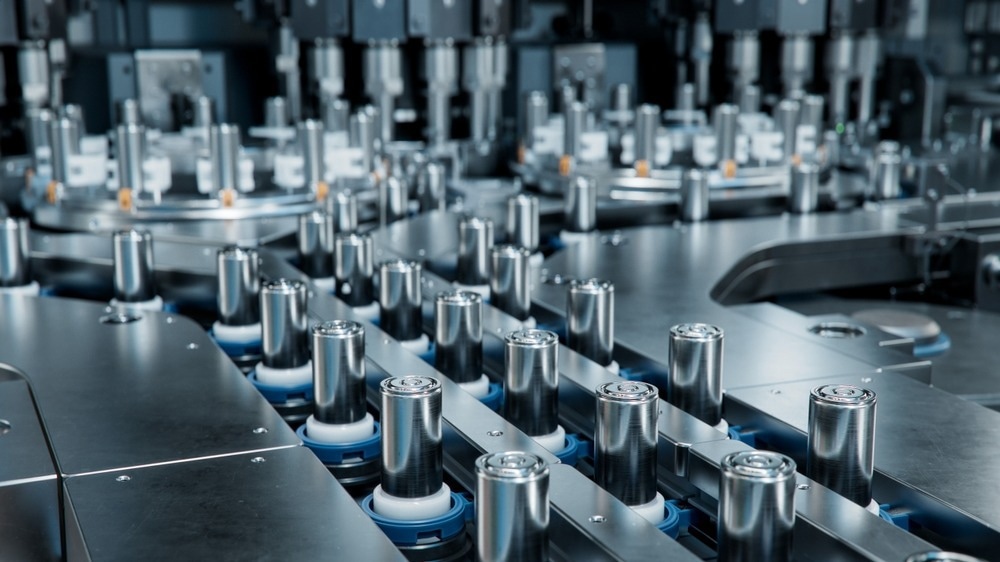 By Taha KhanReviewed by Lexie CornerJun 28 2024
By Taha KhanReviewed by Lexie CornerJun 28 2024Modern electronic technologies like smartphones, laptops, and electric vehicles (EVs) are in high demand. As these technologies evolve with more and more functionalities, the demand for better, more reliable, and more efficient batteries also increases.

Image Credit: IM Imagery/Shutterstock.com
Ensuring battery safety and performance is paramount for both industry and consumers, as battery failures can have devastating consequences. Rigorous battery testing procedures throughout battery development, manufacturing, and usage are crucial for mitigating battery failures and their consequences.
Understanding Batteries and Testing Procedures
Modern technology relies on various types of batteries, each tailored to specific applications. For instance, lithium-ion batteries are extensively used in consumer electronics and EVs due to their long cycle life and high energy density. Other battery types like nickel-metal hydride (NiMH), lead-acid, and solid-state batteries also have relevant energy storage applications.1, 2
Battery testing encompasses a range of procedures designed to assess various performance parameters, such as capacity, power output, voltage, and temperature response under different charging and discharging conditions. These procedures are crucial for verifying that batteries meet industry standards and regulatory requirements, ensuring their safe and reliable operation.3
An example of a battery testing procedure is a two-pulse load test, which determines key battery parameters such as available capacity (AHC), state of charge (SoC), and state of health (SoH). This test involves applying two identical pulses of current to the battery. The first pulse stabilizes the battery's condition, while the second pulse provides the data needed to calculate the parameters by measuring the voltage drop after each pulse.
This method enhances accuracy by mitigating the effects of the battery's previous usage history, offering a quick and reliable means of assessing battery health without requiring extensive discharge testing.3
Advancements in Testing Technology
Significant research and development have been done on battery testing technologies.
Novel Battery Testing Method for Lithium-ion Batteries
In a 2022 study, researchers introduced a novel method for testing lithium-ion batteries that significantly enhances the accuracy and efficiency of battery testing. This new design of experiment (DoE) method integrated both partial discharge test (PDT) and deep discharge test (DDT) to capture comprehensive battery dynamics, which conventional methods using either PDT or DDT alone fail to achieve.4
Experimental results demonstrated that this method reduces the root mean square error by approximately 70 % compared to traditional DoE methods. This improvement in equivalent circuit models (ECMs) accuracy also enhances the precision of state-of-charge estimations, which is critical for the effective simulation and management of battery systems.4
Dynamic Battery Analysis
In a 2018 study, researchers developed a battery testing system for lithium-ion cells that utilizes two programmable power units, including an electronic load and a power supply, controlled through a software/hardware interface. This setup allows for precise application of user-defined charging and discharging cycles.5
The system's flexibility and real-time data acquisition capabilities make it superior to standard proprietary testing equipment. The study enhanced the understanding of battery behavior under dynamic conditions by implementing various battery models and state-of-charge estimation techniques, improving the accuracy and reliability of battery performance assessments.5
Boosting Battery Quality: Automated Image Interpretation
Commercial Developments and Industry Leaders
The market for battery testing equipment is highly competitive, with several companies setting new benchmarks in testing technology.
Simmol
Established in 2021 from the demerger of Emrol, Simmol specializes in advanced battery testing equipment designed for both lead-acid and lithium-ion batteries. Simmol's innovations include state-of-the-art battery management systems and IoT telemetry solutions.
These products are distinguished by their precision, reliability, and integration of advanced data analytics, enabling comprehensive performance assessments.6
Weiss Technik
Weiss Technik provides standard and custom solutions to ensure the safety, reliability, and performance of energy storage devices under various stresses. It offers walk-in test chambers and complex systems for cells, modules, and complete battery packs for performance, aging, climate, and vibration tests, adhering to standards like LV 124 and UN38.3.
Weisstechnik combines extensive experience in lithium-ion battery testing with cutting-edge safety measures, including ATEX and EUCAR compliance, to meet diverse industry needs.7
Diagatron
Diagatron specializes in advanced battery testing equipment, catering to the demands of modern batteries used in everyday devices and complex machinery like submarines and spaceships. It offers single-cell testers for analyzing life cycles and capacities, fuel cell testers, and high-current discharge devices for cost-efficient start tests. Its HV pack testers also simulate driving cycles and charge states. 8
Future Outlook
Future testing systems will likely incorporate more advanced AI algorithms to enhance predictive analytics, enabling earlier detection of potential failures and optimizing battery performance. Trends indicate that innovations will focus on providing real-time data analysis and diagnostics, allowing for immediate adjustments during the battery development process.
As batteries become more powerful and the world moves towards a more sustainable future, safety testing will evolve to address new risks associated with higher energy densities and novel materials.
More from AZoM: How Sustainable are Electric Vehicles?
References and Further Reading
- Köhler, U., Kümpers, J., Ullrich, M. (2002). High-performance nickel-metal hydride and lithium-ion batteries. Journal of power sources. doi.org/10.1016/S0378-7753(01)00932-6
- Lach, J., Wróbel, K., Wróbel, J., Podsadni, P., Czerwiński, A. (2019). Applications of carbon in lead-acid batteries: a review. Journal of Solid State Electrochemistry. doi.org/10.1007/s10008-018-04174-5
- Coleman, M., Hurley, WG., Lee, CK. (2008). An improved battery characterization method using a two-pulse load test. IEEE Transactions on energy conversion. doi.org/10.1109/TEC.2007.914329
- Zhang, C., Guo, Y., Wang, C., Li, S., Curnick, O., Amietszajew, T., Bhagat, R. (2022). A new design of experiment method for model parametrisation of lithium ion battery. Journal of energy storage. doi.org/10.1016/j.est.2022.104301
- Vergori, E., Mocera, F., Somà, A. (2018). Battery modelling and simulation using a programmable testing equipment. Computers. doi.org/10.3390/computers7020020
- Simmol (n.d). Something about Simmol. [Online] Simmol. Available at: https://simmol.com/about/ (Accessed on June 16, 2024)
- Weisstechnik. (n.d). Battery Testing at Weiss. Standard test chambers and customized solutions. [Online] Weisstechnik. Available at: https://www.weiss-technik.com/environmental-simulation/en/detailpages/battery-testing (Accessed on June 16, 2024)
- Diagatron. (n.d). Professional Test Equipment For Battery Laboratories. [Online] Diagatron. Available at: https://www.digatron.com/en-us/Solutions/Battery-Laboratory (Accessed on June 16, 2024)
Disclaimer: The views expressed here are those of the author expressed in their private capacity and do not necessarily represent the views of AZoM.com Limited T/A AZoNetwork the owner and operator of this website. This disclaimer forms part of the Terms and conditions of use of this website.